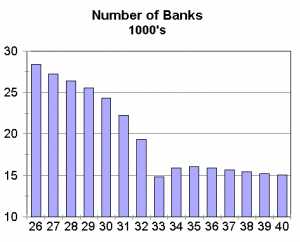- Stock Market Crash of 1929
The stock market crash that occurred on Black Tuesday, October 29, 1929 is not one and the same with the Great Depression. In fact, it was one of the major causes that led to the Great Depression. Two months after the original crash in October, stockholders had lost more than $40 billion dollars. Even though the stock market began to regain some of its losses, by the end of 1930, it just was not enough and America truly entered what is called the Great Depression.
- Bank Failures
Over 9,000 banks failed. Bank deposits were uninsured and thus as banks failed people simply lost their savings. Surviving banks, unsure of the economic situation and concerned for their own survival, stopped being as willing to create new loans. Panicked citizens rushed the banks to withdraw cash that was not there. This is because banks themselves had been part of the over-speculation and over-lending or buying on credit margin.
- American Economic Policy with Europe
As businesses began failing, the government created the Smoot-Hawley Tariff in 1930 to help protect American companies. This charged a high tax for imports thereby leading to less trade between America and foreign countries along with some economic retaliation. The theory was that more people would “buy American” but because other countries also put tariffs on foreign goods all prices went up just as buying power was going down.
http://www.historylearningsite.co.uk/Causes_of_the_Great_Depression.htm
The Great Depression was caused by a lot of factors in the American economy. Due to the bad economy, America went through a tough time of poverty. One of the major causes of the Great Depression was the Stock Market Crash of 1929, also known as Black Tuesday. The Stock Market Crash cost America fortunes and destroyed the economy. There was not enough trade to support the government and therefore America suffered financially. The banks started to fail because people were scared to invest their money in these institutions, which also hurt the economy by dropping the value of the US Dollar. People were not spending as much because either they had no money and jobs, or they feared they would lose their money. This created a dead end for the economy since manufacture came to a halt after there was a huge surplus and there was no purchasing money to maintain employment rates. The gap between the rich and the poor grew, and political leaders were not very helpful in the process. The Smoot-Hawley Tariff put an end to international trade and therefore we could not make money off of resources. Lastly, the drought and Dust Bowl put many citizens in poverty, and many accrued debt.





kudret • Dec 9, 2015 at 9:09 am
i am very glad to read a essay like this, and i have a question about the stockholders lost 40 billions dollars after black Tuesday, there must had a side that got benefit during the Great Depression. so my question is what kind of people would get rich at Great Depression.
Jackie • Jun 3, 2015 at 8:28 am
I think the Great Depression was the worst thing in here. Nobody with jobs, or food, and no where to go. Thats not fair, and they are just charging even higher taxes, how can the people pay even higher taxes with no jobs ?
xoLadyParis • May 12, 2015 at 12:54 pm
I think if the drought had held out a couple of years, the depression stage would have ended sooner.